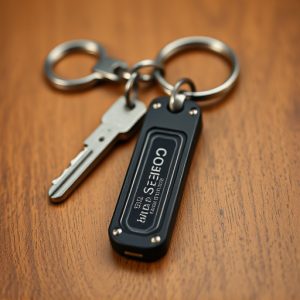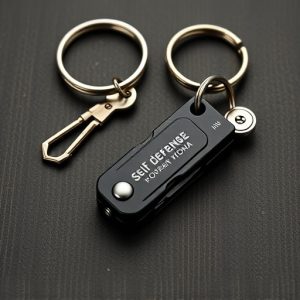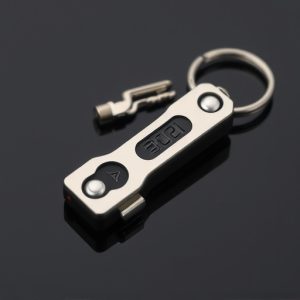Non-Lethal Keychain Defense Tools: Navigating Legal Requirements
Non-lethal keychain defense tools like pepper spray, tasers, or stun guns offer personal security bu…….
Non-lethal keychain defense tools like pepper spray, tasers, or stun guns offer personal security but vary in legality across jurisdictions. Users must understand local regulations regarding carry limits, usage guidelines, age requirements, and permit mandates to ensure compliance. These tools, with mechanisms minimizing harm and visible defensive markings, are subject to regional laws dictating where they can be carried. Staying informed about legislation changes is crucial for responsible use within prescribed parameters, protecting users and retailers from legal repercussions.
In today’s world, personal safety is paramount. Non-lethal keychain defense tools offer a convenient and legal way to deter potential threats. This article provides an in-depth look at the legal requirements surrounding these compact self-defense devices, exploring regional and national laws. We’ll unpack what makes a keychain defense tool legal, highlighting essential features and regulations. Additionally, we’ll emphasize the importance of staying informed about changing legislation to ensure compliance.
- Understanding Non-Lethal Keychain Defense Tools: A Legal Perspective
- Regional and National Laws Governing Self-Defense Devices
- What Makes a Keychain Defense Tool Legal? Essential Features and Regulations
- Staying Informed: Keeping Up with Changes in Keychain Safety Device Legislation
Understanding Non-Lethal Keychain Defense Tools: A Legal Perspective
Non-lethal keychain defense tools, often marketed as personal safety devices, are designed to deter potential attackers and provide users with a sense of security while on the go. These tools typically include items like pepper spray, tasers, or stun guns that are compact and easily portable, fitting comfortably on keychains. From a legal perspective, it’s crucial to understand that while these devices offer a layer of protection, their use is subject to specific regulations and restrictions.
The legality of non-lethal keychain defense tools varies across jurisdictions, with some countries and states allowing their possession for self-defense while others have strict controls or outright prohibit them. Users must be aware of local laws, which often differentiate between various types of non-lethal weapons based on their level of force. For instance, pepper spray is generally legal in many places but comes with restrictions on carry limits and usage guidelines, whereas stun guns might be subject to more stringent regulations, including age restrictions and requirements for special permits.
Regional and National Laws Governing Self-Defense Devices
In many countries, non-lethal keychain defense tools are subject to specific legal frameworks that govern self-defense devices. These laws vary widely across regions, reflecting diverse societal attitudes and needs. At the national level, regulations often classify and categorize personal defense tools based on their potential harm. Tools considered too dangerous or lethal may be strictly regulated or even prohibited, while less harmful alternatives, like non-lethal keychain defenses, often fall into a more lenient category.
Regional laws further refine these categories, with some areas allowing a broader range of self-defense options than others. For instance, certain states or provinces might permit the open carrying of non-lethal self-defense devices, while other regions may restrict them to private homes. Understanding these legal nuances is essential for individuals considering the acquisition and use of non-lethal keychain defense tools to ensure compliance and promote personal safety in an effective yet legally permissible manner.
What Makes a Keychain Defense Tool Legal? Essential Features and Regulations
When it comes to legal requirements for non-lethal keychain defense tools, several key factors determine their validity and use. These devices, designed to provide personal safety, must adhere to specific regulations to ensure they are not misused or deemed offensive weapons. The primary consideration is the tool’s inherent design and purpose; it should be primarily used for self-defense and not as a causative factor for harm or injury.
Essential features that contribute to legal compliance include a non-lethal impact mechanism, such as a rubberized or blunt strike surface, which reduces the risk of serious physical harm. Additionally, these tools should have visible markings or designs indicating their intended purpose as a defense aid rather than a weapon. Many jurisdictions also mandate age restrictions and require users to be of legal maturity, ensuring responsible handling. Moreover, regulations may specify where such devices can be carried, with some limiting their use to private property or requiring them to remain secured within a specific container when in public spaces.
Staying Informed: Keeping Up with Changes in Keychain Safety Device Legislation
Staying informed about the latest legislation is crucial when it comes to keychain safety devices, as laws can change rapidly, especially with advancements in non-lethal keychain defense tools. These compact self-defense gadgets have gained popularity for their convenience and ability to provide individuals with a sense of security. However, with great power comes great responsibility, and manufacturers and users must be aware of the legal boundaries surrounding these devices.
Regularly checking for updates on local and national laws ensures that you are using your keychain defense tool responsibly and within the prescribed parameters. Many countries have specific regulations regarding the type, power output, and permissible use of non-lethal self-defense weapons, such as stun guns or pepper spray. Staying compliant not only protects users but also prevents legal repercussions for manufacturers and retailers.
When considering the legal implications of non-lethal keychain defense tools, it’s crucial to stay informed about regional and national laws. Understanding what makes a device legal, including its essential features and regulatory compliance, is key. By staying abreast of changes in legislation, you can ensure that your choice of self-defense tool adheres to current legal requirements, providing peace of mind in an uncertain world.


